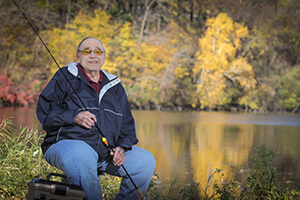Paul R's Story
Heart & Vascular Care“Paul knew he had a bad heart valve since a heart attack in 2011. His cardiologist kept an eye on it, but last fall symptoms became worse. “I couldn’t go 20 feet without huffing and puffing,” said Paul. “I couldn’t stand. I couldn’t walk.””
Exploring the possibilities with MitraClip
Paul Remarcik of Alexandria wakes in the morning and “picks his day.” He may meet friends for coffee, stroll through his neighborhood or tend to his herb garden.
More often than not, he’ll find himself in his vehicle driving around assessing the scenery and stopping at a public access, creek or dock. “I keep my fishing gear in the jeep. If I see a spot, I might try to fish and see what happens.”
One thing Paul doesn’t leave to chance is his mitral regurgitation, a condition where the mitral valve fails to close completely, allowing blood to leak backward into the heart.
Paul knew he had a bad heart valve since a heart attack in 2011. His cardiologist kept an eye on it, but last fall symptoms became worse. “I couldn’t go 20 feet without huffing and puffing,” said Paul. “I couldn’t stand. I couldn’t walk.”
At that time, Paul was introduced to Thom Dahle, MD, one of the cardiologists at CentraCare Heart & Vascular Center who specializes in structural heart problems -- abnormalities, or defects, of the heart muscle or the heart valves that can occur at birth or later in life.
Dr. Dahle recommended MitraClip, a treatment option for those who are not candidates for surgery. In this less-invasive procedure, doctors guide a catheter through a vein in the leg to the mitral valve in the heart. A small metal clip is then attached to the mitral valve, enabling it to open and close more completely without leaking, restoring normal blood flow.
After a one-night hospital stay, Paul returned home, his symptoms vanishing.
According to Dr. Dahle, “there is nothing more rewarding that seeing patients’ improved quality of life and hearing about how they are now enjoying activities and time with loved ones.”
“Before the procedure, I changed my lifestyle quite a bit,” observed Paul. “But at 80 years old I’m amazed at what I’m doing now that I thought I could never do again. I can’t wait to see what I can do next.”
